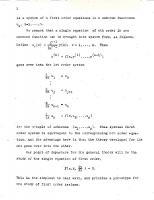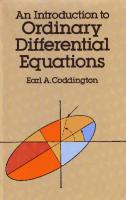Ordinary Differential Equations
411 40 7MB
English Pages 298 [306]
Recommend Papers
File loading please wait...
Citation preview
L.S. Pontryagin
ORDINARY DIFFERENTIAL EQUATIONS
ORDINARY DIFFERENTIAL EQUATIONS By
L. S. PONTRYAGIN Translated from the Russian
by LEONAS KACINSKAS and WALTER B. COUNTS Library of Congress
A T T
A D D IS O N - W E S L E Y HEADING,
PUBLISHING
MASSACHUSETTS
PALO
COMPANY, INC. LONDON ALTO
ADIWES
INTERNATIONAL
SERIES
I N M ATHEM ATICS
A. J.
L o h w a ter
Consulting Editor
Copyright © 1962 ADDISON-WESLEY PUBLISHING COMPANY, INC. Printed in the United States of America ALL RIG H TS R E S E R V E D . OF,
MAY NO T B E
T H IS BOOK, OR P A R TS T H E R E
REPRODUCED
I N A N Y FORM W IT H
O UT W R I T T E N P E R M IS S IO N OF TH E P U B L I S H E R S .
Library of Congress Catalog Card No. 62-17075
PREFACE This book has been written on the basis of lectures which I delivered at the department of mathematics and mechanics of Moscow State Uni versity. In drawing up the program for my lectures, I proceeded on the belief that the selection of material must not be random nor must it rest exclusively on established tradition. The most important and interesting applications of ordinary differential equations to engineering are found in the theory of oscillations and in the theory of automatic control. These applications were chosen to serve as guides in the selection of material. Since oscillation theory and automatic control theory without doubt also play a very important role in the development of our contemporary tech nical culture, my approach to the selection of material for the lecture course is, if not the only possible one, in any case a reasonable one. In attempting to give the students not only a purely mathematical tool suitable for engineering applications, but also to demonstrate the appli cations themselves, I included certain engineering problems in the lectures. In the book they are presented in §13, 27, and 29. I consider that these problems constitute an integral organic part of the lecture course and, accordingly, of this book. In addition to the material presented in the lectures, I have included in the book more difficult problems which were investigated in student seminars. They are contained in §19 and 31. The material contained in §24, 25, and 30 was only partially presented in the lectures. For the convenience of the reader, in the last chapter, the sixth, are presented certain facts from linear algebra in the form in which they are used in this book. In closing, I wish to express my gratitude to my students and to my closest co-workers V. G. Boltyanskiy, R. V. Gamkrelidze, and E. F. Mishchenko, who helped me in the preparation and delivery of the lectures and in writing and editing this book. I want also to note the decisive in fluence upon my scientific interests exerted by the outstanding Soviet specialist in the field of oscillation theory and automatic control theory, Aleksandr Aleksandrovich Andronov, with whom for many years I have had a friendly relationship. His influence has substantially affected the character and direction of this book. Moscow 16 July 1960
L. S. Pontryagin
CONTENTS C hapter 1.
I ntroduction..................................................................................
1
1. 2. 3. 4.
First-order differentiale q u a t i o n s ..................................................... 1 Some elementary integration m e th o d s.............................................. 6 Formulation of the existence and uniqueness theorem . . . . 18 Reduction of a general system of differential equations to a normal s y s te m ........................................................................................................ 25 5. Complex differential e q u a tio n s ....................................................... 33 6. Some properties of linear differential e q u a t i o n s .......................... 39
Chapter 2.
Linear E quations with C onstant C oefficients
.
.
41
7. Linear homogeneous equation with constant coefficients. The case of simple r o o t s ....................................................................................42 8. The linear homogeneous equation with constant coefficients. Case of multiple r o o t s .............................................................................. 50 9. Stable p o ly n o m ia ls ........................................................................ 57 10. The linear nonhomogeneous equation with constant coefficients. . 62 11. Method of e l im in a tio n ...................................................................67 12. The method of complex amplitudes................................................. 76 13. Electrical c irc u its.............................................................................. 80 14. The normal linear homogeneous system with constant coefficients . 94 15. Autonomous systems of differential equations and their phase spaces 103 16. The phase plane of a linear homogeneous system with constant coefficients........................................................................................ 115 Chapter 3.
L inear E quations with V ariable Coefficients
. . 127 17. The normal system of linear equations...........................................127 18. The linear equation of nth order.......................................................137 19. The normal linear homogeneous system with periodic coefficients . 144
Chapter 4.
E xistence T h e o r e m s ........................................................150
20. Proof of the existence and uniqueness theorem for one equation . 150 21. Proof of the existence and uniqueness theorem for a normal system of e q u a tio n s ......................................................................................... 159 22. Local theorems of continuity and differentiability of solutions. . 170 23. First in teg rals................................................................................... 181 24. Behavior of the trajectories on large time in te r v a ls .................... 189 25. Global theorems of continuity and d ifferen tiab ility.................... 192 C hapter 5.
Sta bility ...............................................................................200
26. Lyapunov’s th e o re m ........................................................................ 201 27. The centrifugal governor and the analysis of Vyshnegradskiy . . 213 v
CONTENTS
VI
28. 29. 30. 31.
Limit c y c l e s ...........................................................................................220 The vacuum-tube o scillato r....................................................................236 The states of equilibrium of a second-order autonomous system . 244 Stability of periodic s o l u t i o n s .............................................................. 261
Chapter 6.
....................................................................277 32. The minimal annihilating p o ly n o m ial...................................................277 33. Matrix fu n c tio n s .....................................................................................284 34. The Jordan form of a matrix....................................................................291 Linear A l g
ebra
I n d e x ..................................................................................................................296
CHAPTER 1 INTRODUCTION This chapter is devoted primarily to the definition of those concepts which will be studied subsequently. What is a system of ordinary differ ential equations, what do we mean by a solution of it, and how many of these solutions exist? These are the basic questions which we shall attempt to answer in this chapter. The number of solutions is determined by theorems of existence and uniqueness, which will not be proved here, but only formulated. The proofs of these and of a number of other theorems of the same type are given in the fourth chapter, but theorems previously formulated in the first chapter are repeatedly used, so that their meaning is thus clarified. In addition to such basic information, solutions of differen tial equations of several of the simplest types are given in the first chapter. At the end of the chapter complex differential equations and their com plex solutions are studied, and elementary facts concerning systems of linear differential equations are given. 1. First-order differential equations. Equations in which the unknowns are functions of one or several variables and which contain not only the functions themselves, but also their derivatives, are called differential equations. If the unknown functions are functions of several variables, then the equations are called 'partial differential equations; in the opposite case, i.e., for the case of functions of only one independent variable, the equations are called ordinary differential equations. In this book we shall deal only with the latter. In applications to physics the time is taken as the independent variable, which is conventionally designated by the letter t; throughout this book the independent variable will be designated by t. Unknown functions will be designated by x, y, z, and so on. Derivatives of functions with respect to t will as a rule be designated by dots: x = dx/dt, x = d2x/dt2, and so on. When this is inconvenient or impossible, we shall denote the order of a derivative by an upper index in parentheses; for example, x n) = dnx/dtn. First we shall study the first-order differential equation. This equation may be written in the form Fit, x, x) = 0.
(1)
Here t is the independent variable, x the unknown function, x = dx/dt the derivative, and F a given function of three variables. The function F need not be defined for all values of its arguments; therefore we speak of 1
2
INTRODUCTION
[CHAP. 1
the domain of definition B of the function F or simply, the domain B of F; here we have in mind a domain in the space of the three variables x, y, z. Equation (1) is called a first-order equation because it contains only the first derivative x of the unknown function x. A function x = tp(t) of the independent variable t, defined on a certain interval rx < t < r 2 (the cases rx = ~ c c , r 2 = +oo are not excluded), which, when substituted for x in equation (1), reduces (1) to an identity on the entire interval rx < t < r2, is called a solution of equation (1). The interval rq < t < r2 is called the interval of definition of the solution 93, ■•■, 9i > 9m,
are valid. Since by (24) we have 61 ^ 0, we may assume that 61 = 1. We shall now replace the indeterminates x l, . . . , xn by new indetermi nates y l, . . . , y n by setting x1 = yl;
xl = yl + blpq'~ qiyx, i = 2, . . . , m; x 1 = yl, i = m + 1, . . . , n.
(25)
The relations (25) can be solved for the new indeterminates y x, . . . , y n, namely, y x = x 1;
yl = xl — f>lp?1_?tr 1, i = 2, . . . , m; yl = xl, i = m + 1, . . . , n.
(26)
Substituting the new indeterminates y l, . . . , yn into (19) in place of x l, . . . , xn, we obtain the new system of equations
E L*W = fit),
j=
l,-..,n .
(27)
S = 1
It is immediately evident that the order q* of the system (27) with respect to the function y 1is less than qx, and its orders with respect to the remain ing unknowns y2, . . . , y n are correspondingly equal to 92, . . . , qn- Thus the order q* of (27) is less than the order q of (19). If we consider the transformations (25) and (26) as linear transformations of the variables y x, . . . , y n into the variables x x, . . . , xn, and conversely, with coefficients which are polynomials in p, then it is evident that the determinant of each of the linear transformations (25) and (26) is equal to +1. From this it follows that the determinant D*(p) of (27) is equal to the determinant D{p) of (19). Thus the difference between the order and the degree of the determinant in system (27) is less than in system (19); by applying the transformation described a finite number of times, we obtain a normalizable system. Now let (28) xl =






![Ordinary Differential Equations [1.0]
9780486158211](https://ebin.pub/img/200x200/ordinary-differential-equations-10-9780486158211.jpg)



